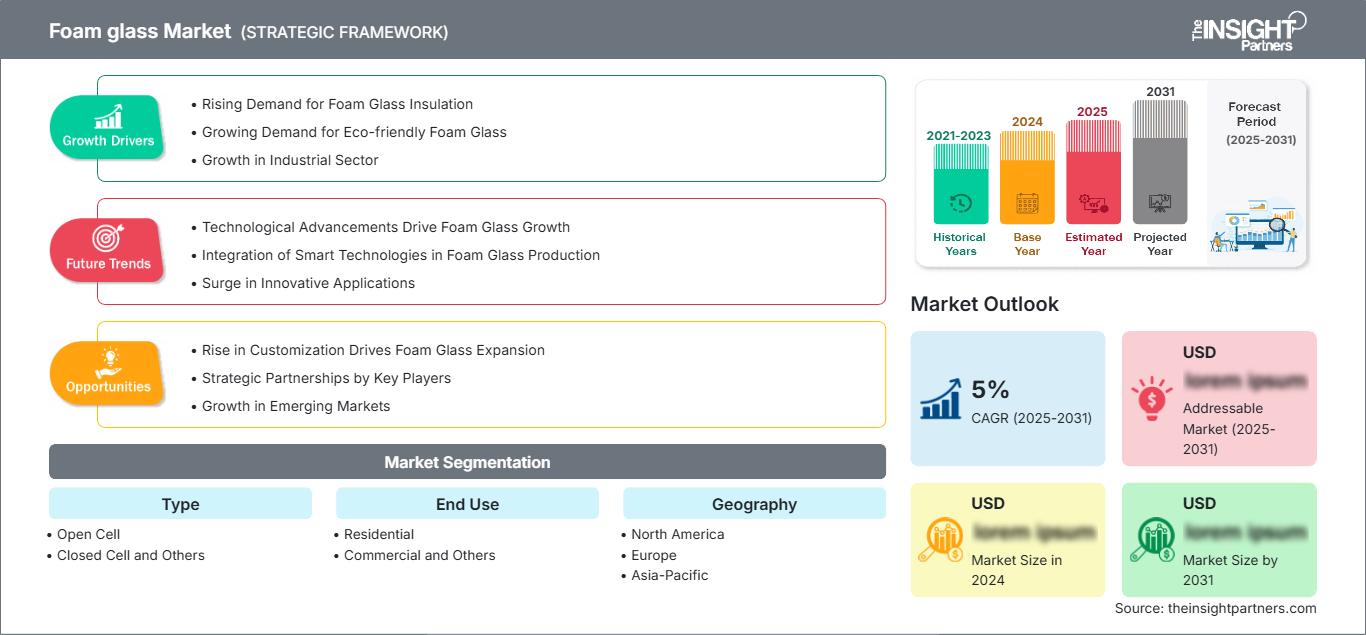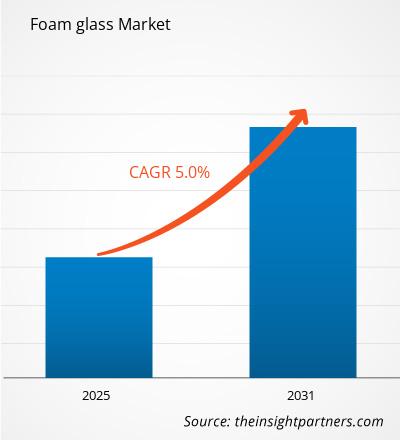页面已更新 :
Jan 2025
预计泡沫玻璃市场在 2025 年至 2031 年期间的复合年增长率为 5%,市场规模将从 2024 年的 XX 百万美元扩大到 2031 年的 XX 百万美元。
该报告按类型(开孔、闭孔和其他)细分。该报告进一步根据最终用途(住宅、商业和其他)进行了分析。全球分析进一步细分为区域和主要国家。该范围涵盖所有主要细分市场的全球、区域和国家层面的市场规模和预测。该报告以美元提供上述分析和细分市场的价值。该报告提供了主要市场参与者的市场状况的关键统计数据,并提供了市场趋势和机遇。
报告目的
Insight Partners 撰写的《泡沫玻璃市场》报告旨在描述当前的格局和未来的增长、主要驱动因素、挑战和机遇。这将为各种业务利益相关者提供见解,例如:
- 技术提供商/制造商:了解不断变化的市场动态并了解潜在的增长机会,使他们能够做出明智的战略决策。
- 投资者:对市场增长率、市场财务预测和整个价值链中存在的机会进行全面的趋势分析。
- 监管机构:规范市场政策和警察活动,旨在最大限度地减少滥用,维护投资者的信任和信心,并维护市场的完整性和稳定性。
泡沫玻璃市场细分类型
- 开孔
- 闭孔及其他
最终用途
- 住宅
- 商业及其他
自定义此报告以满足您的要求
您将免费获得任何报告的定制,包括本报告的部分内容,或国家级分析、Excel 数据包,以及为初创企业和大学提供超值优惠和折扣
泡沫玻璃市场: 战略洞察

- 获取本报告的主要市场趋势。这个免费样本将包括数据分析,从市场趋势到估计和预测。
泡沫玻璃市场增长动力
- 泡沫玻璃隔热材料需求不断增长:建筑行业对隔热材料的需求不断增长,是泡沫玻璃市场的主要推动力之一。泡沫玻璃卓越的隔热性能使其能够有效减少建筑物的能耗。随着住宅和商业建筑节能的必要性,泡沫玻璃因其在墙体、屋顶和地板隔热方面的应用而越来越受欢迎。
- 环保泡沫玻璃需求不断增长:人们对环境的日益关注以及对生态安全建筑材料的需求是影响泡沫玻璃市场的主要因素。泡沫玻璃利用废玻璃生产,使其成为一种与当前可持续建筑实践同步的绿色建筑材料。此外,泡沫玻璃具有惰性、防潮、防虫和防火的特性,使其成为一种绿色建筑材料。随着绿色建筑认证成为越来越多建筑商和设计师关注的焦点,预计泡沫玻璃的需求也将增加。
- 工业领域的增长:泡沫玻璃市场的另一个市场驱动因素是工业领域的增长,尤其是制造业和物流业的增长。泡沫玻璃正在迅速渗透到许多工业领域,包括包装、制冷和轻质填充材料。其强度和热性能使其成为易碎物品和设备运输和包装的理想选择。随着更多行业的开放和现有技术的革新,泡沫玻璃市场也呈现出蓬勃发展的势头。
泡沫玻璃市场未来趋势
- 技术进步推动泡沫玻璃增长:泡沫玻璃因其在生产能力方面采用的较新技术以及泡沫玻璃制造技术的产品改进而持续受到欢迎。通过改进除尘工艺以改善灌注剂,有助于获得具有高隔热性和低密度的泡沫玻璃等级。这些因素促使制造商以比以前更低的价格生产出更高效的产品,从而使泡沫玻璃更容易在更广泛的应用中推广。
- 智能技术在泡沫玻璃生产中的应用:另一个值得关注的方面是,智能技术融入建筑和制造业的趋势正在影响整个泡沫玻璃市场。这得益于物联网和其他传感器的应用,这些传感器能够在生产和使用过程中测量材料和环境参数。因此,质量保证得以加快,泡沫玻璃产品能够达到预期质量,从而更有效地将泡沫玻璃推向市场,最终赢得客户的满意。
- 创新应用激增:人们越来越倾向于重新思考旨在促进泡沫玻璃膨胀的孵化过程。例如,科学家认为它有助于隔音和防火,甚至可以作为轻质混凝土的填充物。此类创新策略有助于扩大泡沫玻璃市场,找到其他领域的新客户,从而实现进一步增长。
泡沫玻璃市场机遇
- 定制化趋势推动泡沫玻璃扩张:制造商能够通过生产可根据不同行业定制的泡沫玻璃产品来拓展业务。这些企业脱颖而出的秘诀在于专注于市场上的专业领域,例如冷藏设施的专业隔热或城市隔音,从而满足不同行业的需求。
- 主要参与者的战略合作伙伴关系:战略合作伙伴关系有助于与建筑公司、建筑师和研发机构建立合作伙伴关系,以开发创新解决方案。创新发展包括新配方或生产方法、对现有生产流程和应用的新改进,或这些创新的强化应用。这种关系还可以促进专业知识的交流和人力资源的采购,从而使行业更加广阔和进步。
- 新兴市场的增长:随着越来越多的人城镇化以及基础设施的不断完善,泡沫玻璃市场在许多新兴国家都具有增长潜力。这一全球发展趋势为企业提供了拓展业务范围和定制产品以适应这些市场的机会。通过在当地生产泡沫玻璃,可以最大限度地降低成本并提高供应链效率,使这些地区的建筑商更容易使用该材料。
泡沫玻璃市场区域洞察
The Insight Partners 的分析师已详尽阐述了预测期内影响泡沫玻璃市场的区域趋势和因素。本节还讨论了北美、欧洲、亚太地区、中东和非洲以及南美和中美洲的泡沫玻璃市场细分和地域分布。
泡沫玻璃市场报告范围
| 报告属性 | 细节 |
|---|---|
| 市场规模 2024 | US$ XX million |
| 市场规模 2031 | US$ XX Million |
| 全球复合年增长率 (2025 - 2031) | 5% |
| 历史数据 | 2021-2023 |
| 预测期 | 2025-2031 |
| 涵盖的领域 |
By 类型
|
| 覆盖地区和国家 | 北美
|
| 市场领导者和主要公司简介 |
|
泡沫玻璃市场参与者密度:了解其对业务动态的影响
泡沫玻璃市场正在快速增长,这得益于终端用户需求的不断增长,而这些需求的驱动因素包括消费者偏好的不断变化、技术进步以及对产品优势的认知度不断提高。随着需求的增长,企业正在扩大产品线,不断创新以满足消费者需求,并抓住新兴趋势,从而进一步推动市场增长。

- 获取 泡沫玻璃市场 主要参与者概述
主要卖点
- 全面覆盖:该报告全面涵盖了泡沫玻璃市场的产品、服务、类型和最终用户的分析,提供了整体格局。
- 专家分析:该报告基于对行业专家和分析师的深入了解而编写。
- 最新信息:由于涵盖了最新信息和数据趋势,该报告确保了业务相关性。
- 定制选项:此报告可以根据特定客户要求进行定制,并恰如其分地适应业务策略。
因此,泡沫玻璃市场研究报告可以帮助引领解读和理解行业情景和增长前景的线索。尽管可能存在一些合理的担忧,但本报告的总体优势往往大于劣势。
- 历史分析(2 年)、基准年、预测(7 年)及复合年增长率
- PEST和SWOT分析
- 市场规模、价值/数量 - 全球、区域、国家
- 行业和竞争格局
- Excel 数据集
近期报告
相关报告
客户评价
购买理由
- 明智的决策
- 了解市场动态
- 竞争分析
- 客户洞察
- 市场预测
- 风险规避
- 战略规划
- 投资论证
- 识别新兴市场
- 优化营销策略
- 提升运营效率
- 顺应监管趋势
我们的客户































87-673-9708

ISO 9001:2015



 获取免费样品 - 泡沫玻璃市场
获取免费样品 - 泡沫玻璃市场